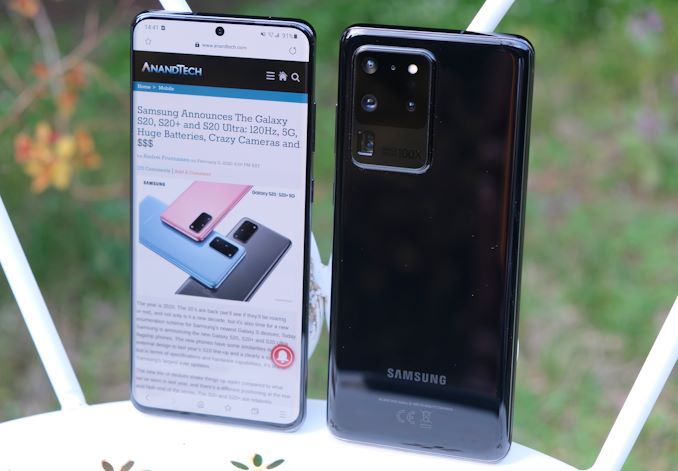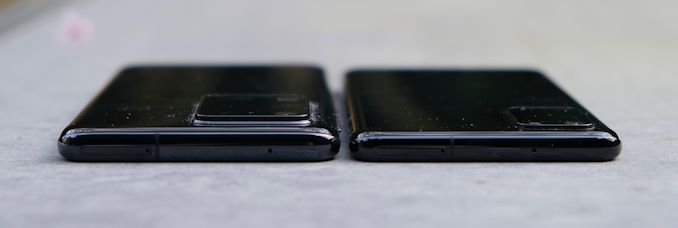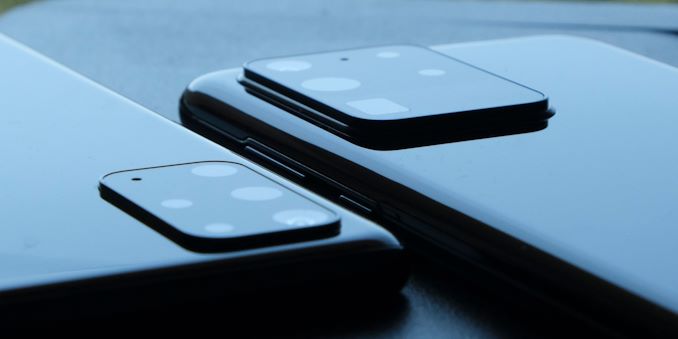The Samsung Galaxy S20+, S20 Ultra Exynos & Snapdragon Review: Megalomania Devices
by Andrei Frumusanu on April 3, 2020 9:30 AM ESTDesign, Continued: An Ultra Mega Phone
Of course, the flagship entry in the 2020 Galaxy line-up is the Galaxy S20 Ultra. Samsung here literally supersized the design, making a much larger and heftier version that goes beyond what the “regular” plus models offer. While the S20+ fits in the same form-factor as the S10+, the S20 Ultra is clearly a bigger phone, more in line with the behemoth that was the rare S10 5G.
The biggest differences in the design aren’t found in the front of the phone – here the Ultra essentially just looks the same as the other two S20 devices and you’d be hard pressed to tell them apart other than their size. Turn it around though, and you’ll see the Ultra’s enormous camera housing that is very distinct from any other phone on the market.
The first thing you’ll notice when handling the Ultra, beyond it having a larger footprint, is that it’s clearly a thicker phone. It’s 1mm thicker than the S20+, which is a 12.8% increase and is very noticeable. The sides of the phones are still curved as on the S20+, however the curve is now deeper, and the metal frame on the side of the phone is a sliver thicker than on the smaller variants.
The ergonomics are still good for a phone of this size, but of course, you’ll need to be used to having a phone this size.
Another aspect where the S20 Ultra just outsizes the S20+ is in terms of weight. At 220g, the phone is much closer in weight to an iPhone Max than it is the lighter, 187g S20+. With the weight does come a larger battery, which is now 5000mAh (typical capacity), an 11% increase over the S20+’s 4500mAh capacity.
Then there’s the camera bump of the Ultra. There’s no better word to describe it other than "enormous". The problem here isn’t that Samsung had to extend the camera housing thickness in order to integrate the complex camera modules and optics which the Ultra offers, but that they did so in what I find to be a very boring and ugly manner.
Most notably, the rim of the camera housing is just a raised metal element that protrudes out, which is in contrast to the curved design of the rest of the phone. Samsung probably decided that leaving such a big protrusion doesn’t look so good, so they added in another step in the frame between the glass back and the full protrusion – best way to describe it is that it looks like a gasket. The whole thing just looks very cheap and doesn’t compare to the filleted glass design from Apple or even the filleted “gasket” that Huawei uses in the recently announced P40 Pro. My biggest pet peeve about Samsung’s design is that it’s super prone to collecting dust in the three grooves around the camera – both of my S20 Ultras are full of it right now as I’m writing this. It feels like a rushed design with very little manufacturing refinement.
One other difference I noticed is in the speaker audio quality. The S20 Ultra does sound fuller and a bit less high pitched, probably due to the larger internal reverberation space of the design. It’s the better sounding phone of the S20 series.
Whether the S20 Ultra can justify its existence will largely depend on how its special camera hardware will be able to differentiate itself from the S20 and S20+. In terms of design, other than it being a big phone, I do think Samsung somewhat missed the mark with the camera housing. A filleted edge of the camera protrusion could have done wonders, so hopefully it’s something that the company will look into for future designs.














137 Comments
View All Comments
katakuri4744 - Wednesday, April 8, 2020 - link
Hi Andrei,Appreciate such a detailed article. I have one question, how did you pull the voltage curve, is there a command?
I had S10 exynos then upgraded it to S20+ exynos, both the articles had this voltage curve though the Snapdragon variant does not, I would like to check the same for my device as well.
helloworld_chip - Monday, April 6, 2020 - link
Though 865's compute efficiency loks pretty good, from some other data points I heard that its infrastructure power (impacting real user-daily activities, light-loaded scenarios) is quite BAD. Would be good if more such comparisons are available to confirm this, since it determines how long people can actually use a phone.s.yu - Monday, April 6, 2020 - link
Idle is relatively inefficient and the numbers here show.helloworld_chip - Monday, April 6, 2020 - link
Gotcha thx.I am thinking we should calculate bat-capacity / hours instead of just hours to really show how is the SoCs overall efficiency.
Bigger and Bigger battery really make us feel heavier, we should push the designer harder to make these more efficiency instead of just using larger and larger battery.
FunBunny2 - Tuesday, April 7, 2020 - link
"Bigger and Bigger battery really make us feel heavier, we should push the designer harder to make these more efficiency instead of just using larger and larger battery. "last time I looked, most of the battery goes to driving the screen. so resurrect your original iPhone. the notion that batteries will have increasing power density this millennium is fantasy. Li is the smallest source of electrons available. well, unless you're willing to carry around a Hindenburg in your pocket.
s.yu - Tuesday, April 7, 2020 - link
Technically I'm with you but I just don't trust all developers to sufficiently optimize their code. You see that Peachncream guy who always claims that his dinosaur fossils run everything smoothly but it just doesn't happen to me. The way it is my S6E(backup device) that literally runs 3 apps in all(not even simultaneously, AFAIK) with animations turned off in dev mode is much slower than his...some really old low end phone, same thing with the battery, a large capacity gives me peace of mind over any optimization because I know that nothing could eat through the battery too fast.watzupken - Monday, April 6, 2020 - link
This is the reason why I will not consider any Samsung Galaxy phone that is running on Exynos SOC. If it is on the low/ mid end, I can't complain about it. But when shelling out for a flagship, I don't see why one would pay the same amount for the slower variant and you don't have the choice to get the superior version locally.andyfrut - Monday, April 6, 2020 - link
Is the S20+ (855) comparable with the S20 Ultra (855) in battery life in 120hz?andyfrut - Monday, April 6, 2020 - link
snapdragon 865*Ayaan_G - Tuesday, April 7, 2020 - link
The 5G addition to the Samsung Galaxy series will really give it a boost in another level !